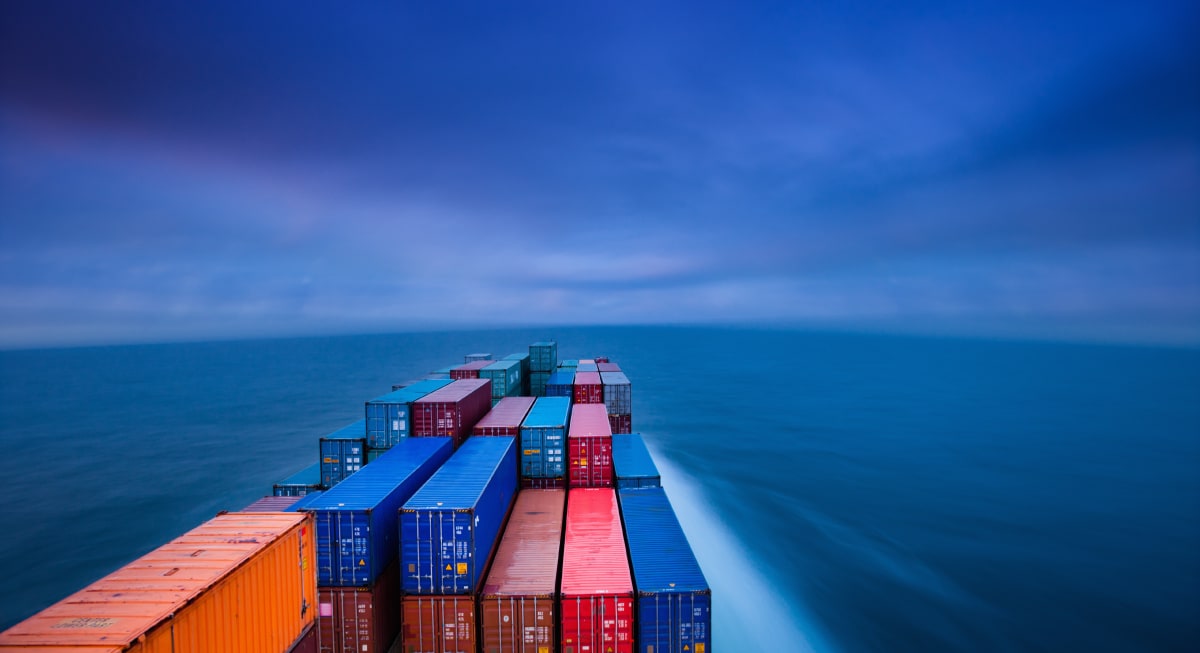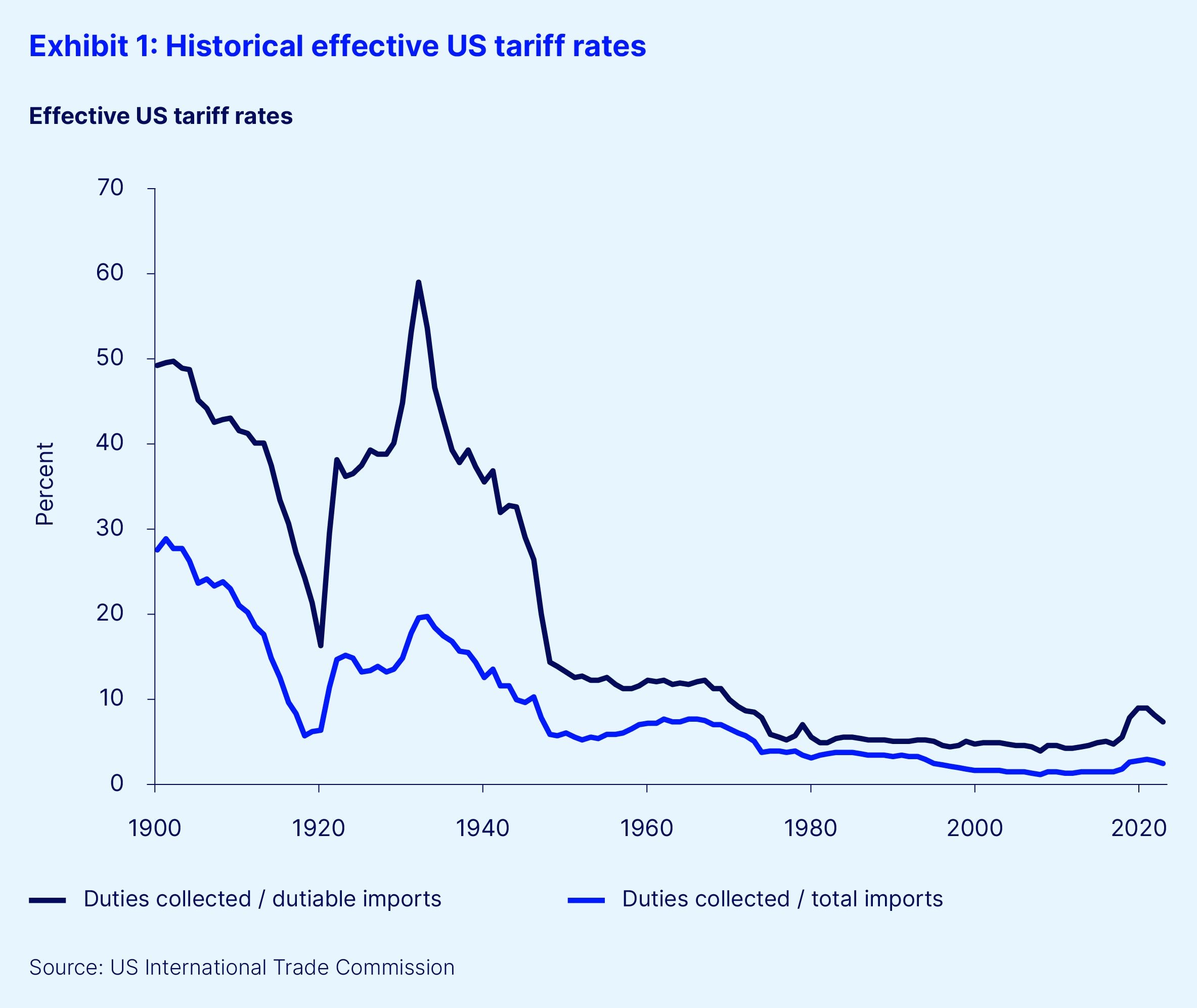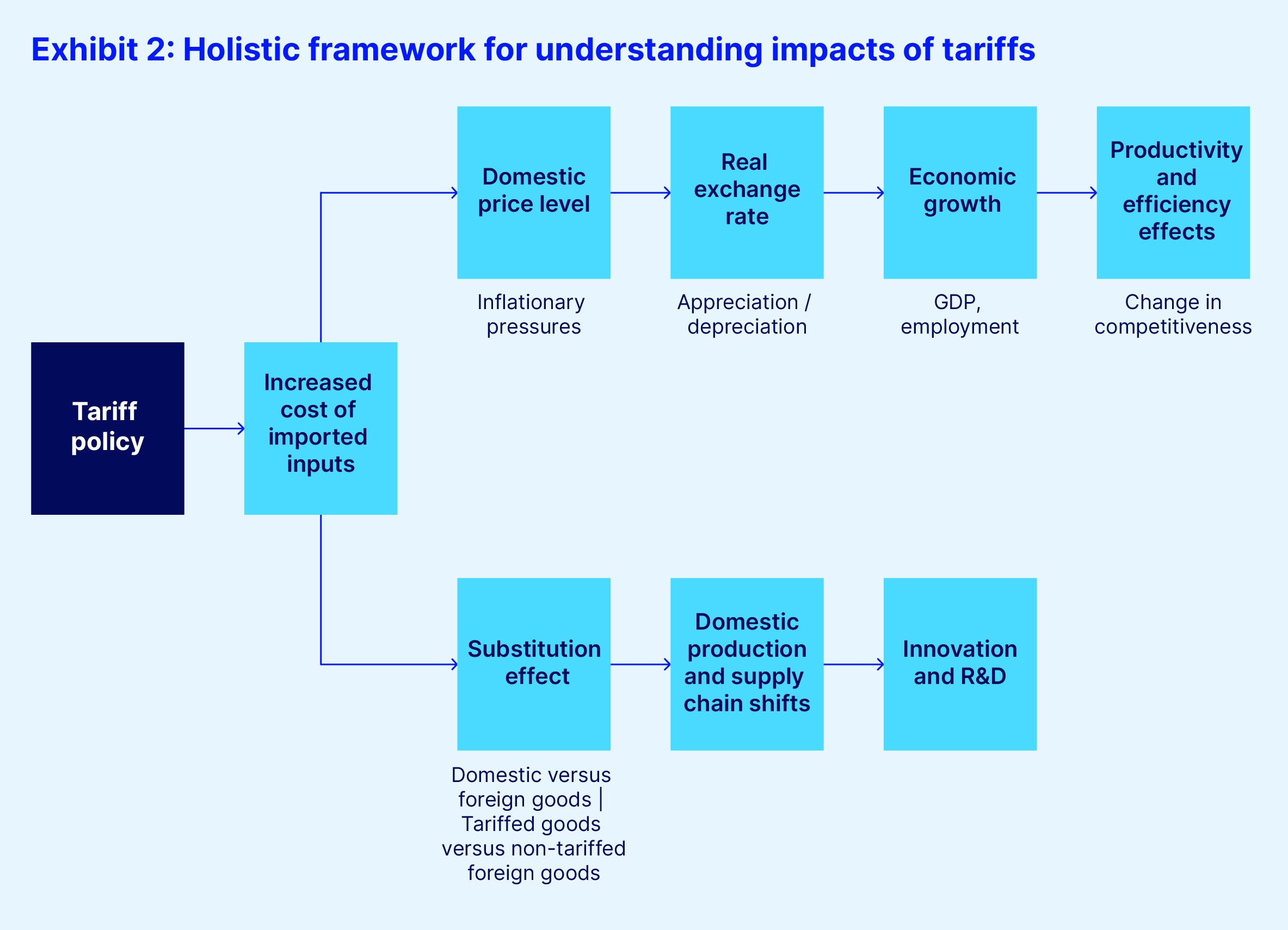Insights
February 2025
The price of protectionism:
Understanding the economic tradeoffs of tariffs

In this paper, we explore the broader implications of tariffs, underscoring the tradeoffs inherent in tariff policy and their potential economic and financial consequences.

Ramu Thiagarajan
Head of Thought Leadership,
State Street

Jennifer Bender
Global Chief Investment Strategist and Head of Investment Strategy & Research, State Street Global Advisors

Michael Metcalfe
Head of Macro Strategy,
State Street Global Markets
Summary
The economic and financial impacts of tariffs are complex and multi-faceted, influencing both domestic industries and broader market dynamics. On the one hand, tariffs aim to protect domestic industries, address trade imbalances and support emerging sectors, allowing them to develop and become competitive. They can also enhance national security by reducing dependence on foreign suppliers for critical goods and serve as leverage in trade negotiations to encourage trading partners to adopt fairer practices.
On the other hand, while tariffs are intended to achieve these positive outcomes, their broader consequences can extend beyond their original objectives. By raising the cost of imported goods, tariffs can increase consumer prices, particularly in sectors reliant on global supply chains. Over time, they may reduce efficiency by insulating less competitive firms, misallocating resources and discouraging innovation. Additionally, tariffs can limit access to advanced technologies, slowing technological progress and hindering long-term economic development.
Although substitution effects can offset some costs by encouraging shifts to domestic alternatives or trade partners, these adjustments often come with their own inefficiencies, such as higher logistical complexities, increased transportation costs and supply chain disruptions.
The impact of tariffs on financial markets is more difficult to quantify. Markets generally experience heightened volatility in response to tariff announcements, particularly in sectors heavily integrated into global trade networks. Their effect on exchange rates is nuanced, shaped by factors such as trade flows, market expectations and policy responses.
This paper explores the broader implications of tariffs, underscoring the tradeoffs inherent in tariff policy and their potential economic and financial consequences.
1. Introduction
In recent years, tariff policies have resurfaced as a focal point in global economic discussions. With the new United States administration’s promotion of tariffs as a policy tool, it is critical to understand their potential implications. From an economic theory standpoint, tariffs are import taxes that alter the relative prices of imported goods compared to domestically produced ones. The downstream effects can be profound, impacting inflation, exchange rates, economic growth, industrial productivity and long-term innovation.
Historically, there are limited precedents to guide us. Prior to 2018, tariffs were most prominently used in the US in the 1910s-1930s, notably with the Smoot-Hawley Tariff Act of 1930, widely regarded as a contributor to the Great Depression. In the modern era, significant tariff actions were initiated by the first Trump administration and continued under the Biden administration, targeting steel and aluminum (2018 onward), Chinese imports (2018 onward), European aircraft and agricultural products (2019-2021) and solar panels (2018 onward).
Exhibit 1 illustrates the historical decline in US-effective tariff rates from approximately 1900 to 2023, with tariffs on dutiable goods and overall imports showing a sharp decrease over time due to trade liberalization and economic integration. This highlights the shift from protectionist policies to a more open trade environment, with a slight recent uptick reflecting renewed tariff policies.

Exhibit 2 illustrates the primary channels through which tariffs influence an economy. Arrows represent the direction of causality or impact, while text in parentheses highlights potential outcomes or intermediating factors.

Each node will be examined in greater detail in the sections that follow, starting with the more well-established economic channels and concluding with the less certain financial ones.
2. Economic implications: Tariffs and inflation
Tariffs have the potential to drive up prices by increasing the cost of imported goods. In the short term, higher costs for raw materials and intermediate goods often translate into higher prices for final goods. When demand for these goods is inelastic, these higher costs can be passed on to consumers. For instance, the 2018 tariffs imposed by the US raised the average price of US manufacturing by approximately 1 percent, according to Amiti et al.1 (2019). This inflationary impact was particularly pronounced in industries where imported inputs are critical, such as electronics and machinery. Additionally, sectors reliant on global supply chains faced compounded inflationary effects due to the cascading costs of tariffs across multiple production stages.
The pass-through effect on consumer prices, however, proved to be more complex. Using a combination of customs and PriceStats goods-level data, Cavallo et al.2 (2021) found that while most tariffs were absorbed by US importers, end consumer prices were only significantly affected when tariffs were very high — as seen with products like washing machines, for example. In contrast, when tariffs levied were 20 percent or less — on goods such as handbags, bicycles and refrigerators — the impact on consumer prices was de minimis. The authors conclude that during the 2018-2019 Trump era, the size of the tariffs and their perceived longevity likely influenced US retailers’ decision to absorb the costs through reduced margins.
Tariffs can also suppress inflation indirectly by reducing aggregate demand. Higher import prices can lead consumers to cut back on overall spending, dampening inflationary pressures in the broader economy. This duality was evident during the 2018-2019 US-China trade war, when inflationary pressures were mitigated by a decline in consumer demand for tariffed goods. Over time, inflationary pressures may also be moderated if consumers shift consumption to domestically produced alternatives — provided such alternatives exist and have sufficient supply capacity. Notably, the Federal Reserve’s own Tealbook3 scenario analysis in 2018 found that a 15 percent universal tariff risked pushing the US economy into recession.
One mitigating factor of tariffs is the substitution effect, where consumers and businesses shift their consumption and sourcing patterns to adapt to higher prices on tariffed goods. When tariffs increase the price of imports, consumers may substitute these goods with domestically produced alternatives or imports from countries not subject to the tariffs. For example, during the US-China trade war, many US importers reoriented supply chains toward Vietnam, Mexico and other countries as alternative suppliers, thereby reducing direct exposure to tariffs.
While substitution can offset some negative impacts of tariffs, it is rarely a cost-free adjustment. Trade diversion often results in higher transportation costs, supply chain inefficiencies and shifts to suppliers that may not offer the same price, quality or reliability. Additionally, in industries dependent on specialized inputs, substitution may be severely constrained, amplifying economic disruptions.
The extent of substitution effects depends largely on the availability of comparable alternatives. In markets with close substitutes, the impact of tariffs may be less severe. However, in cases where substitutes are limited, businesses may face higher production costs and ultimately pass them on to consumers. Trade diversion can also introduce inefficiencies if firms are forced to source inputs from higher-cost producers in connector countries, further complicating the overall impact of tariffs.
While tariffs have an immediate inflationary impact by raising import costs, their long-term effects depend on how businesses adjust supply chains. If firms successfully shift to alternative suppliers or increase domestic production, inflationary pressures may subside over time. However, supply chain rigidities can prolong price increases, particularly in industries dependent on specialized inputs that lack substitutes. Empirical evidence suggests that inflationary trends tend to be strongest in the short term, particularly in consumer goods sectors where price pass-through is highest.
3. Economic implications: Tariffs and economic growth
Tariff policies are often intended to provide short-term protection to domestic industries, shielding them from foreign competition and potentially boosting employment and output. When tariffs successfully redirect demand from foreign suppliers to domestic producers, they can temporarily increase real gross domestic product (GDP), particularly if idle capacity exists that can be swiftly utilized.
In the long term, however, tariffs have the potential to dampen economic growth. By raising costs and reducing trade volumes, tariffs can distort market dynamics, resulting in inefficiencies and lower productivity. Higher prices for imported goods may discourage consumption and investment, exerting downward pressure on overall economic output. Additionally, uncertainty surrounding tariff policy can lead businesses to delay investment decisions, further weakening long-term growth prospects.
Empirical evidence supports this view. For example, Furceri et al.4 (2019) found that a one standard deviation increase in tariffs results in a 0.4 percent decline in output growth over five years. Similarly, Boer and Rieth5 (2024) found that reversing the 2018-2019 tariff measures would have yielded a cumulative output gain of 4 percent over three years. The negative growth impact of tariffs is particularly pronounced in economies that are heavily trade-dependent or lack viable domestic substitutes for imported goods. Furthermore, sustained tariffs can provoke retaliatory measures from trading partners, exacerbating growth constraints and amplifying economic uncertainty.
However, some historical analyses suggest that tariffs played a role in fostering economic growth under certain conditions. For instance, during the late 19th century, the US implemented tariffs to protect its burgeoning industries, which may have contributed to its rapid industrialization. This period, known as the Gilded Age, saw significant economic expansion, with tariffs providing revenue for the government and protection for nascent industries. Similarly, in the 20th century, economies like South Korea and Japan leveraged temporary trade barriers alongside aggressive export-driven industrial policies to enhance domestic competitiveness. These cases suggest that when tariffs are combined with strategic industrial policy – such as investment in technology, education and infrastructure – they may serve as catalysts for long-term economic transformation.
While these historical examples demonstrate that tariffs can contribute to economic development under certain conditions, their success has largely relied on being part of a broader industrial strategy rather than a standalone policy. Given today’s globalized and interdependent economy, the effectiveness of tariffs as a growth mechanism remains highly context-dependent and requires complementary policies to mitigate unintended consequences.
4. Impact on financial markets: Stocks, bonds and exchange rates
Financial markets generally respond sharply to tariff announcements due to heightened uncertainty and risk pricing (see Exhibit 3). US equities, particularly large-cap stocks, experienced significant volatility during the 2018-2019 US-China trade war, with the S&P 500 losing 5 percent on key tariff announcement days (CFA Institute, 2024).7 This volatility reflected investor concerns over the potential for higher costs, weaker consumer demand and disruptions to global supply chains.
In the medium term, the impact of tariffs differs across asset classes. Equities tend to experience pronounced short-term volatility as investors react to trade policy shifts. However, over time, higher costs, weakened consumer demand and corporate restructuring, reduce earnings growth impacting stock valuations.
Bonds, particularly US Treasuries, may benefit from tariffs if they contribute to economic slowdowns prompting central banks to lower interest rates to stimulate growth. This can make fixed-income assets more attractive. However, inflation risks can complicate bond market dynamics. If tariffs trigger sustained inflationary pressures, bond yields may rise as investors demand higher returns to compensate for inflation risks.
The ultimate financial market impact of tariffs depends on three key factors:
- The duration and severity of trade conflicts – Long-term disputes heighten uncertainty and disrupt investment flows.
- Prevailing monetary policy – If central banks cut interest rates in response to trade-related slowdowns, financial markets may partially offset negative effects.
- Global capital mobility – Investors respond dynamically to shifting risk-adjusted returns, reallocating capital based on expected tariff outcomes.
In currency markets, tariffs can significantly influence exchange rates by altering:
- Trade balances – Reducing imports may improve the trade balance, strengthening the domestic currency.
- Capital flows – Uncertainty can deter foreign investment, weakening the domestic currency.
- Investor expectations – Speculative positioning can amplify exchange rate volatility.
In theory, tariffs imposed by a country can lead to currency appreciation if they improve trade balances by reducing demand for foreign goods and, consequently, foreign currency. Conversely, if tariffs lead to economic slowdowns, they may erode investor confidence, causing capital outflows and currency depreciation.

In practice, exchange rate dynamics are far more complex, as they depend on multiple macroeconomic factors beyond just tariffs, such as capital mobility, market expectations, trade elasticities and the relative economic strength of the countries involved. For instance, Jeanne and Son8 (2024) found that the tariffs imposed by the US in 2018-2019 did not meaningfully impact the US dollar, explaining at most one-fifth of the dollar’s effective appreciation. By contrast, these tariffs significantly depreciated the Chinese yuan, accounting for around two-thirds of its effective depreciation. These findings suggest that while tariffs can influence currency markets, they often play a secondary role compared to broader dynamics such as capital flows, monetary policy and investor sentiment.
In cases of US tariffs on other countries, higher tariffs can strengthen the US dollar by reducing imports and improving the trade balance. However, they also risk weakening the dollar if economic slowdown erodes investor confidence. During the 2018-2019 trade war, the Chinese yuan depreciated significantly, illustrating the dynamic interplay between tariffs, trade policy and market forces.
The interplay of tariffs and foreign exchange also affects capital flows, as investors reassess risk-adjusted returns in response to policy uncertainties. While the US dollar is expected to strengthen in the near term due to heightened trade disruptions, prolonged tariff policies could weaken the dollar beyond 2025. As global trade flows shift and foreign countries respond with their own protectionist measures, long-term US trade deficits may widen, eroding investor confidence in dollar-denominated assets.
5. Conclusion
Tariffs embody an inherent tension in economic policy: They can provide short-term political and economic gains, but can also introduce long-term inefficiencies and risks. While they can protect domestic industries, enhance trade leverage and generate government revenue, their broader implications — inflationary pressures, reduced productivity and market volatility — are deeply intertwined and require careful policy consideration.
The macroeconomic consequences of tariffs depend on their scope, duration and retaliatory risks. When used strategically and temporarily, tariffs may help foster domestic industry growth and encourage investment in alternative supply chains. Although tariffs can improve trade balances and provide short-term support to domestic industries, they can also lead to currency appreciation, reduce export competitiveness and incentivize trade diversion rather than solving trade imbalances.
Retaliatory tariffs, imposed by affected trade partners, further disrupt investment flows and corporate confidence, creating an environment where economic growth slows due to uncertainty, rather than direct trade costs alone. Moreover, tariffs rarely resolve trade imbalances. Unless universal tariff increases are applied consistently, trade flows will simply shift to the next most cost-effective location.
Policymakers must navigate this complex landscape carefully, considering alternative policy tools such as targeted subsidies, supply chain incentives or international cooperation. While substitution effects and trade diversion mitigate some costs, they also introduce inefficiencies, further complicating policy outcomes. The emergence of connector trade flows underscores the adaptability of global markets, but also highlights possible limitations of tariffs as a sustainable policy tool.
Given the interconnected nature of the global economy, the costs of unilateral trade barriers often outweigh their benefits. The real impact of tariffs is rarely straightforward, requiring a nuanced assessment of both intended benefits and potential unintended consequences.
Acknowledgements
The authors would like to thank Elliot Hentov, Hanbin Im and Eric Garulay for productive discussions and insightful comments on earlier versions of this paper.



